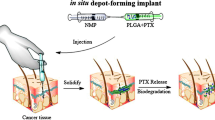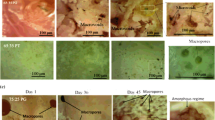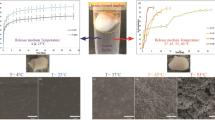Abstract
Poly(ε-caprolactone) implants containing etoposide, an important chemotherapeutic agent and topoisomerase II inhibitor, were fabricated by a melt method and characterized in terms of content uniformity, morphology, drug physical state, and sterility. In vitro and in vivo drug release from the implants was also evaluated. The cytotoxic activity of implants against HeLa cells was studied. The short-term tolerance of the implants was investigated after subcutaneous implantation in mice. The original chemical structure of etoposide was preserved after incorporation into the polymeric matrix, in which the drug was dispersed uniformly. Etoposide was present in crystalline form in the polymeric implant. In vitro release study showed prolonged and controlled release of etoposide, which showed cytotoxicity activity against HeLa cells. After implantation, good correlation between in vitro and in vivo drug release was found. The implants demonstrated good short-term tolerance in mice. These results tend to show that etoposide-loaded implants could be potentially applied as a local etoposide delivery system.









Similar content being viewed by others
REFERENCES
Instituto Nacional de Câncer José Alencar Gomes da Silva. Estimativa 2012: Incidência de Câncer no Brasil. http://www.inca.gov.br/estimativa/2012/. Accessed 12 December 2012.
Weinberg BD, Blanco E, Gao J. Polymer implants for intratumoral drug delivery and cancer therapy. J Pharm Sci. 2008;97:1681–702.
Wolinsky JB, Colson YL, Grinstaff MW. Local drug delivery strategies for cancer treatment: gels, nanoparticles, polymeric films, rods, and wafers. J Control Release. 2012;159:14–26.
Kempe S, Mäder K. In situ forming implants—an attractive formulation principle for parenteral depot formulations. J Control Release. 2012;161:668–79.
Agarwal P, Rupenthal ID. Injectable implants for the sustained release of protein and peptide drugs. Drug Discov Today. 2013;18:337–49.
Kang YM, Kim GH, Kim JI, Kim DY, Lee BN, Yoon SM, et al. In vivo efficacy of an intratumorally injected in situ-forming doxorubicin/poly-(ethylene glycol)-b-polycaprolactone diblock copolymer. Biomaterials. 2011;32:4556–64.
Wang Q, Wang J, Lu Q, Detamore MS, Berkland C. Injectable PLGA based colloidal gels for zero-order dexamethasone release in cranial defects. Biomaterials. 2010;31:4980–6.
Büyüktimkin B, Wang Q, Kiptoo P, Stewart JM, Berkland C, Siahaan TJ. Vaccine-like controlled-release delivery of an immunomodulating peptide to treat experimental autoimmune encephalomyelitis. Mol Pharm. 2012;9:979–85.
Woodruff MA, Hutmacher DW. The return of a forgotten polymer—polycaprolactone in the 21st century. Prog Polym Sci. 2010;35:1217–56.
Shirazi FH, Bahrami G, Stewart DJ, Tomiak E, Delorme F, Noel D, et al. A rapid reversed phase high performance liquid chromatographic method for determination of etoposide (VP-16) in human plasma. J Pharm Biomed Anal. 2001;25:353–6.
Hande KR. Etoposide: four decades of development of a topoisomerase II inhibitor. EJC. 1998;34:1514–21.
Reif S, Kingreen D, Kloft C, Grimm J, Siegert W, Schunack W, et al. Bioequivalence investigation of high dose etoposide and etoposide phosphate in lymphoma patients. Cancer Chemother Pharmacol. 2001;48:134–40.
Shah S, Pal S, Gude R, Devi S. A novel approach to prepare etoposide-loaded poly(n-vinyl caprolactam-co-methylmethacrylate) copolymeric nanoparticles and their controlled release studies. J Appl Polym Sci. 2012;127:4991–9.
Reif S, Nicolson MC, Bisset D, Reid M, Kloft C, Jaehde U, et al. Effect of grapefruit juice intake on etoposide bioavailability. Eur J Clin Pharmacol. 2002;58:491–4.
Snehalatha M, Venugopal K, Saha RN, Babbar AK, Sharma RK. Etoposide loaded PLGA and PCL nanoparticles II: biodistribution and pharmacokinetics after radiolabeling with Tc-99m. Drug Deliv. 2008;15:277–87.
Tang BC, Fu J, Watkins N, Hanes J. Enhanced efficacy of local etoposide delivery by poly(ether-anhydride) particles against small cell lung cancer in vivo. Biomaterials. 2010;31:339–44.
Jain J, Fernandes C, Patravale V. Formulation development of parenteral phospholipid-based microemulsion of etoposide. AAPS PharmSciTech. 2010;11:826–31.
Patlolla RR, Vobalaboina V. Folate-targeted etoposide-encapsulated lipid nanospheres. J Drug Target. 2008;16:269–75.
Reddy LH, Adhikari JS, Dwarakanath BSR, Sharma RK, Murthy RR. Tumoricidal effects of etoposide incorporated into solid lipid nanoparticles after intraperitoneal administration in Dalton’s lymphoma bearing mice. AAPS J. 2003;8:E254–62.
Dhanaraju MD, Sathyamoorthy N, Sundar VD, Suresh C. Preparation of poly(epsilon-caprolactone) microspheres containing etoposide by solvent evaporation method. Asian J Pharm Sci. 2010;5:114–22.
Schaefer JM, Singh J. Effect of isopropyl myristic acid ester on the physical characteristics and in vitro release of etoposide from PLGA microspheres. AAPS PharmSciTech. 2000;1:49–54.
Brazilian Pharmacopeia. 5th ed. Brasília: ANVISA; 2010.
Solano AGR, Silva GR, Fialho SL, Cunha-Junior AS, Pianetti GA. Development and validation of a high performance liquid chromatographic method for determination of etoposide in biodegradable polymeric implants. Qui Nova. 2012;35:1239–43.
Patel DH, Patel MP, Patel MM. Formulation and evaluation of drug free ophthalmic films prepared by using various synthetic polymers. J Young Pharm. 2009;1:116–20.
United States Pharmacopeia. 32nd ed. Rockville: The United States Pharmacopeial Convention; 2009.
Shah JC, Chen JR, Chow D. Preformulation study of etoposide: identification of physicochemical characteristics responsible for the low and erratic oral bioavailability of etoposide. Pharm Res. 1898;6:408–12.
Costa P, Lobo JMS. Modeling and comparison of dissolution profiles. Eur J Pharm Sci. 2001;13:123–33.
Siepmann J, Siepmann F. Mathematical modeling of drug delivery. Int J Pharm. 2008;364:328–43.
Li C, Cheng L, Zhang Y, Guo S, Wu W. Effects of implant diameter, drug loading and end-capping on praziquantel release from PCL implants. Int J Pharm. 2010;386:23–9.
Oliveira AR, Molina EF, Mesquisa PC, Fonseca JLC, Rossanezi G, Pedrosa MFF, et al. Structural and thermal properties of spray-dried methotrexate-loaded biodegradable microparticles. J Therm Anal Calorim. 2012;1:1–11.
Cheng L, Lei L, Guo S. In vitro and in vivo evaluation of praziquantel loaded implants based on PEG/PCL blends. Int J Pharm. 2010;387:129–38.
Silva-Junior AA, Matos JR, Formariz TP, Rossanezi G, Scarpa MV, Egito EST, et al. Thermal behavior and stability of biodegradable spray-dried microparticles containing triamcinolone. Int J Pharm. 2009;368:45–55.
Jasti BR, Du J, Vasavada RC. Characterization of thermal behavior of etoposide. Int J Pharm. 1995;118:161–7.
Mohanty AK, Dilnawaz F, Mohanty C, Sahoo SK. Etoposide-loaded biodegradable amphiphilic methoxy (poly ethylene glycol) and poly(epsilon caprolactone) copolymeric micelles as drug delivery vehicle for cancer therapy. Drug Deliv. 2011;17:330–42.
Wu Z, Guo D, Deng L, Zhang Y, Yang Q, Chen J. Preparation and evaluation of a self-emulsifying drug delivery system of etoposide–phospholipid complex. Drug Dev Ind Pharm. 2011;37:103–12.
Yadav KS, Sawant KK. Formulation optimization of etoposide loaded PLGA nanoparticles by double factorial design and their evaluation. Curr Drug Deliv. 2010;7:51–64.
Marsac PJ, Li T, Taylor LS. Estimation of drug–polymer miscibility and solubility in amorphous solid dispersions using experimentally determined interaction parameters. Pharm Res. 2009;26:136–51.
Wang S, Guo S, Cheng L. Disodium norcantharidate loaded poly(ε-caprolactone) microspheres I. Preparation and evaluation. Int J Pharm. 2008;350:130–7.
Cheng L, Guo S, Wu W. Characterization and in vitro release of praziquantel from poly(ε-caprolactone) implants. Int J Pharm. 2009;377:112–9.
Drewinko B, Barlogie B. Survival and cycle-progression delay of human lymphoma cells in vitro exposed to VP-16-213. Cancer Treat Rep. 1976;60:1295–306.
Katoh O, Yamada H, Hiura K, Aoki Y, Kuroki S. Clinical pharmacology and toxicity of low daily administration of oral etoposide in advanced lung cancer patients. J Clin Pharmacol. 1991;31:1155–60.
Clark PI, Slevin ML, Joel SP, Osborne RJ, Talbot DI, Johnson PWM, et al. A randomized trial of two etoposide schedules in small-cell lung cancer: the influence of pharmacokinetics on efficacy and toxicity. J Clin Oncol. 1994;12:1427–35.
Hande KR. Topoisomerase II inhibitors. Updat Cancer Ther. 2008;3:13–26.
Montecucco A, Biamonti G. Cellular response to etoposide treatment. Cancer Lett. 2007;252:9–18.
Toffoli G, Corona G, Basso B, Boiocchi M. Pharmacokinetic optimisation of treatment with oral etoposide. Clin Pharmacokinet. 2004;43:441–66.
Kiliçay E, Demirbilek M, Türk M, Güven E, Hazer B, Denkbas EB. Preparation and characterization of poly(3-hydroxybutyrate-co-3-hydroxyhexanoate) (PHBHHX) based nanoparticles for targeted cancer therapy. Eur J Pharm Sci. 2011;44:310–20.
Rello-Varona S, Gámez A, Moreno V, Stockert JC, Cristóbal J, Pacheco M, et al. Metaphase arrest and cell death induced by etoposide on HeLa cells. Int J Biochem Cell Biol. 2003;38:2183–95.
Clark PI, Cottier B. The activity of 10-, 14-, and 21-day schedules of single-agent etoposide in previously untreated patients with extensive small cell lung cancer. Semin Oncol. 1992;19 Suppl 14:36–9.
Carney DN, Grogan L, Smit EF, Harford P, Berendsen HH, Postmus PE. Single-agent oral etoposide for elderly small cell lung cancer patients. Semin Oncol. 1990;1 Suppl 2:49–53.
Bhardwaj U, Sura R, Papadimitrakopoulos F, Burgess DJ. PLGA/PVA hydrogel composites for long-term inflammation control following s.c. implantation. Int J Pharm. 2010;384:78–86.
Patil SD, Papadmitrakopoulos F, Burgess DJ. Concurrent delivery of dexamethasone and VEGF for localized inflammation control and angiogenesis. J Control Release. 2007;117:68–79.
Anderson JM. Biological responses to materials. Annu Rev Mater Res. 2001;31:81–110.
Angel M, Carcaboso AM, Bramuglia GF, Chantada GL, Fandiño AC, Chiappetta DA, et al. Topotecan vitreous levels after periocular or intravenous delivery in rabbits: an alternative for retinoblastoma chemotherapy. Invest Ophthalmol Vis Sci. 2007;48:3761–7.
Allhenna D, Boushehria MAS, Lamprechta A. Drug delivery strategies for the treatment of malignant gliomas. Int J Pharm. 2012;436:299–310.
Callewaert M, Dukic S, Gulick LV, Vittier M, Gafa V, Andry MC, et al. Etoposide encapsulation in surface-modified poly(lactide-co-glycolide) nanoparticles strongly enhances glioma antitumor efficiency. J Biomed Mater Res A. 2013;101:1319–27.
Kuno N, Fujii S. Biodegradable intraocular therapies for retinal disorders: progress to date. Drugs Aging. 2010;27:117–34.
ACKNOWLEDGMENTS
The authors would like to thank Quiral Química do Brasil S.A. for etoposide donation and CNPq, FAPEMIG, and Brazilian Pharmacopoeia for the financial support.
Author information
Authors and Affiliations
Corresponding author
Rights and permissions
About this article
Cite this article
Solano, A.G.R., de Fátima Pereira, A., Pinto, F.C.H. et al. Development and Evaluation of Sustained-Release Etoposide-Loaded Poly(ε-Caprolactone) Implants. AAPS PharmSciTech 14, 890–900 (2013). https://doi.org/10.1208/s12249-013-9977-6
Received:
Accepted:
Published:
Issue Date:
DOI: https://doi.org/10.1208/s12249-013-9977-6




